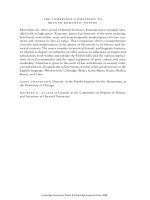The cambridge companion to british roman 60
Bạn đang xem bản rút gọn của tài liệu. Xem và tải ngay bản đầy đủ của tài liệu tại đây (38.76 KB, 1 trang )
n i c k g ro o m
fundamental for understanding attitudes toward ancient Britain in the period
and for the Romantic reception of ancient societies more generally, and the
most appropriate place to begin an account of the Gothic aesthetic is of
course in a graveyard. Thomas Gray’s “Elegy Written in a Country ChurchYard” (1750) is particularly apt. Gray wrote much in the neoclassical style,
and shares many of the same concerns as his contemporary, Pope, such as the
death of meaning in the new age of capitalism and mass-print culture, and
“universal darkness” covering all. But Gray does not share Pope’s Schadenfreude at the descent of society into Dulness; rather, he fears this annihilation,
and his fear becomes intensified through the lens of medieval history until
he is facing utter extinction. Here is the genesis of the figure of the Romantic
poet: writers gradually left their place within the witty and urbane circles of
Augustan social commentary and became outsiders, haunted by an obsessive
historical imagination.10
In the “Elegy,” the poet’s anxiety is expressed by the poem moving from
the neverland of counterfactual or speculative English history (those “mute,
inglorious Miltons” – what never was and what will never be) to an oral
rhapsody, and finally to the written word carved on a stone in the country
churchyard: “graved on the stone beneath yon aged thorn” (l. 116). The poem
is itself an epitaph, and establishes a convention of mortal epigraphy in later
Romantic poems, where, as we shall see, fragments of text are discovered
and deciphered, either written on gravestones or other pieces of memorial
furniture, or actually inscribed into the land in more suggestive ways. It is
also a poem that struggles to find its own voice, and its expressly allusive
style has been accused of being “an anthology of literary clich´es available to
every minimally educated reader.”11
So already in Gray we have recognizable themes of what was to become
characteristic of the Gothic: graves and funerary monuments, memory and
loss, mortality and melancholia, all combining in an acute awareness of the
transience of human endeavour, of loneliness, of the weight of the past, of
antiquity, and of an inability to write. But Gray’s most influential mouthpiece
for this fear of history, and the strange terror of not-being and never-havingbeen, was the figure of the bard, who briefly stands proud of history atop
Snowdon in one of the most spectacular images of the period – Thomas
Jones painted “The Bard” in 1774, and the subject was still popular in
1817, when John Martin produced his iconic depiction. In Gray’s poem
“The Bard” (1757), the central speaker gives voice to Gray’s fear in a wild
fugue of inspiration. He is the last of his race, recording the extermination of
his people – the Welsh druidic society – by the invading Anglo-Norman king
Edward I, while also predicting the eventual extinction of Edward’s line and
the triumph of the Tudors. His is a lone voice in the devastation: no one will
38
Cambridge Collections Online © Cambridge University Press, 2008









